Contents
How sometimes everyone wants the garden to turn from something purely functional into a luxurious flower garden and please the eye not only with its productivity, but also with its unique beauty. This is not so difficult to achieve using the principle of mixed landings. In this case, vegetables can also be beautifully planted in the form of various flower patterns and combined with beautiful and fragrant protectors from all kinds of pests. An interesting solution that will help diversify both the garden and flower beds is the planting of the so-called ornamental cabbage. It can be planted in flower beds, and along the paths, forming a border out of it, and even in the garden.

It contains a large amount of selenium, which is an excellent natural immunomodulator. To remove bitterness, its leaves can be frozen before eating.
In foreign countries, which we are so accustomed to being equal to, this cabbage has been grown for a long time and flower beds of stunning beauty are formed from it. In Our Country, the fashion for ornamental cabbage is also beginning to gain momentum, although it is still not used very often in private gardens. But it is not as difficult to grow as many other flowers. Its only feature is that in apartments without balconies it will most likely not be possible to grow good seedlings.
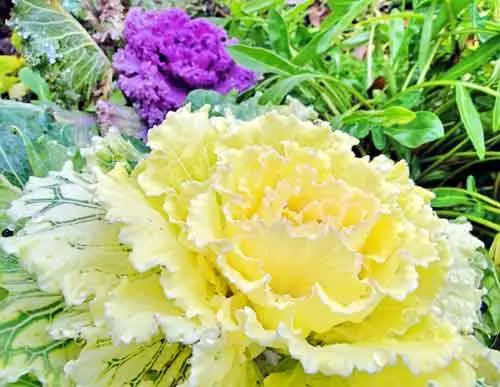
The easiest way to grow ornamental cabbage from seeds is to have a private house with land and a greenhouse. But if you have been permanently living in the country since May, then it is quite possible to try to grow it by direct sowing of seeds into the ground. But first things first.
What is ornamental cabbage
Under the general name of ornamental cabbage, they combined several varieties of leafy garden cabbage, which originate from fodder leafy forms. The plants are biennials, with a gorgeous rosette of leaves or even heads in the first year, and in the second year they bloom and you can collect seeds from them, unless, of course, you grow hybrid forms. Plant height can be very varied, as well as shapes and colors.
Distinguish:
- Varieties that form large up to 80 cm, colored rosettes on a shortened stem. The leaves themselves can be solid, and slightly wavy, and corrugated, and strongly dissected. See photo below.

- Varieties that form small heads of cabbage on a thin, rather high stem, reaching a height of 70-80 cm. These varieties of ornamental cabbage most of all resemble small palm trees. The color and shape of the leaves can also be very diverse.

- Varieties, on a long tall stem, sometimes from one to one and a half meters in height, covered with corrugated leaves of various shapes, resembling some exotic trees, as in the photo below.

The maximum decorative effect of the plant is reached by autumn. Color shades begin to appear especially brightly after the first frost. And, given that ornamental cabbage plants easily tolerate transplantation at almost any age, they can easily decorate any places in flower beds, flower beds or vegetable gardens in autumn, where summer plants have already faded and fruited.
Terms of planting
When can you plant ornamental cabbage when growing it from seed?
The main varieties of ornamental cabbage belong to mid- and late-ripening groups. This means that from the emergence of seedlings to the achievement of the so-called technological maturity, it usually takes from 140 to 160 days. If we mean ornamental cabbage, then usually rosettes of leaves open at the end of summer – in August. And from September to October, and in some regions even to November, they will delight with their truly luxurious appearance.
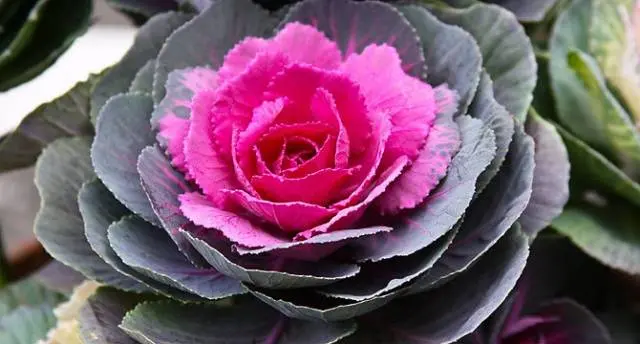
Therefore, the earliest time when it makes sense to plant ornamental cabbage for seedlings is mid-March.
And the main problems in its cultivation will be associated with excess heat rather than its lack. Therefore, if you are going to grow cabbage seedlings at home, in a warm or even hot apartment, then it is better to immediately abandon this idea and wait until the end of April or the beginning of May. During these periods, it is also quite possible to plant ornamental cabbage for seedlings. Moreover, if you do not have the opportunity to provide seedlings with additional lighting, then it is better to postpone the sowing of cabbage seeds to a later date, when daylight hours increase.
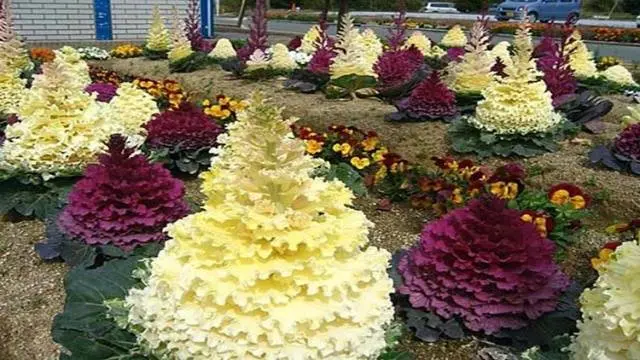
The process of planting cabbage for seedlings
When planting cabbage, the question most often arises – how to do it right. In order to grow good seedlings of cabbage, two main methods are used: with a pick and without a pick.
Pick-up landing
This method is used, first of all, in cases where there is a desire and opportunity to grow a sufficiently large number of seedlings of ornamental cabbage. Ornamental cabbage is a very unpretentious plant. The only problem at the seedling stage can be the defeat of various fungal infections, to which all types of cabbage are weak. To avoid this problem, it is necessary to subject both the soil for sowing and the seeds to special treatment.
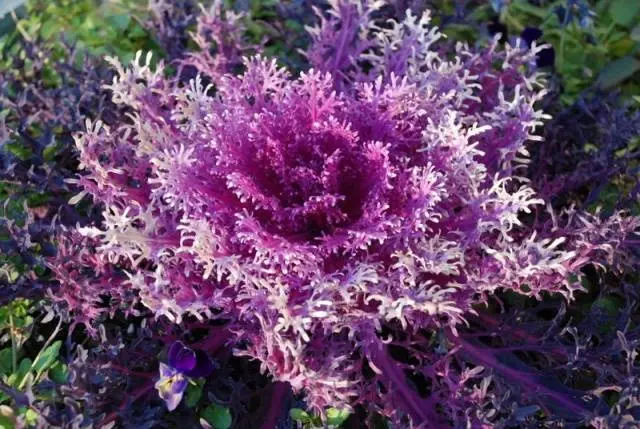
Before planting, be sure to soak your own homemade cabbage seeds for several hours in a phytosporin solution.
As for the soil for sowing seeds, you can buy it either ready-made in the store, or cook it yourself.
- For this, ½ of the usual garden soil is taken (only not from the beds where vegetables grew before). It is best to take the land from under fruit trees.
- ½ part of completely decomposed humus is added.
- For 10 kg of such a mixture, 100 g of vermiculite or sand and 1 tablespoon of wood ash are added.
For complete disinfection, the soil for planting ornamental cabbage must first be steamed well in the oven in order to destroy all sources of infection. After complete cooling, the soil is spilled with a solution of phytosporin to a wet-wet state and left for several hours. Only then can you directly sow the seeds.

The technique for sowing seeds of ornamental cabbage is as follows:
- The boxes prepared in advance are filled with moist treated soil, so that the layer thickness is at least 5 cm.
- The earth is lightly compacted and grooves about 0,5-1 cm deep are made in it with a suitable object.
- The distance between the grooves is left at 3 cm.
- Prepared seeds of ornamental cabbage are laid out with a match or a toothpick along the grooves so that the distance between them is at least 1 cm.
- From above, the grooves are covered with the same soil and lightly compacted, so that there are no air pockets in the soil.
- From above, the plantings are again watered a little, so that as a result the soil remains well moistened, but not wet.
- The box is covered with a film and tied with an elastic band around the perimeter to create a small greenhouse effect.
- The box is placed in a warm place with a temperature of +18°C to +24°C.
- Light at this stage of seed germination is optional.
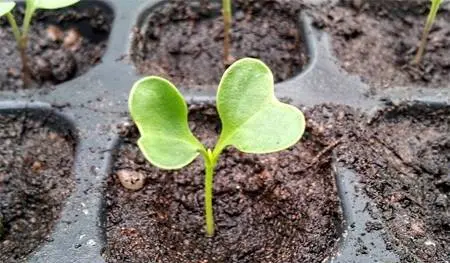
Already 3-5 days after sowing the seeds, the first shoots of cabbage may appear.
They say that it is better to see once than to read many times, so, with the process of planting cabbage for seedlings, the video below will help to clearly illustrate all the subtleties of this process:
It would be ideal if you can find a place for seedlings with a temperature of about + 8 ° C – + 10 ° C, but in any case the temperature should not exceed + 14 ° C – + 16 ° C. Cabbage seedlings also need a lot of light. But there is no special need to water it at this stage. If you did everything correctly when planting, then seedlings should have enough moisture in the ground until the moment when it needs to be dived. In extreme cases, cabbage can sometimes be sprayed from a spray bottle, but not watered. This technique will provide additional safety of plants at this stage from fungal diseases, especially from black leg.

After 8-12 days, when the first true leaf begins to form, the seedlings must be picked out.
For this, the required number of cups or pots is prepared, with a minimum volume of about ¼ liter. They are filled with soil, similar in composition to that in which the seeds were sown and again spilled with a solution of phytosporin.
In all containers, a recess is made with a stick or pencil, about 2-3 cm in size, since the root of the seedlings is quite long. Each cabbage sprout is carefully dug up with a plastic disposable spoon and placed in the prepared hole. Make sure that the root does not bend to the side when planting. The sprout can be deepened into the ground almost to the very cotyledon leaves. Then the earth around the sprout is gently compacted. All plants are transplanted in the same way. Ornamental cabbage plants are planted in the ground starting from the end of April and in May.
Landing without picking

This process, in fact, is not much different from sowing the seeds described above, except for one nuance. When sowing, two or three cabbage seeds are usually placed in each pot. A few days after germination, only one of the strongest sprouts is left in the pot. The rest are carefully cut off with nail scissors at ground level. If there are few seeds and you feel sorry for them, you can try to plant the sprouts immediately in separate containers. There is a chance that some of them will take root.
Sowing cabbage in the ground
As mentioned above, the best way to grow good ornamental cabbage seedlings is to sow the seeds directly into the ground. This can be done in the middle lane already starting from the end of April. For this, a bed with loose and fertile soil is preliminarily prepared. It is covered with a thick non-woven material on arcs. Immediately before sowing, the earth is spilled with hot water and cabbage seeds are sown in the prepared grooves using the same technology. Lightly sprinkled with light fertile soil, compacted and covered with non-woven material on top. Under these conditions, seed germination is highly dependent on the ambient temperature and can take up to 2-3 weeks.

Bottles can be removed after seed germination. Seedlings in such conditions are able to withstand short-term frosts down to -4 ° C. But it will grow strong, healthy, stocky and able to even catch up with room seedlings soon.
It is better to start watering it when the first leaf opens and, when watering, alternate the phytosporin solution with a solution of any complex fertilizer.
Thus, having mastered the cultivation of ornamental cabbage from seeds, you can easily decorate not only flower beds, but also any place on your site with luxurious rosettes of multi-colored flowers.












